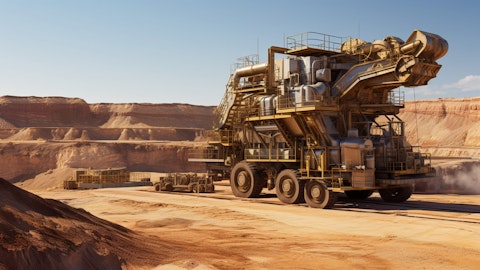Shimmick Corporation Common Stock (NASDAQ:SHIM) Q3 2025 Earnings Call Transcript November 13, 2025
Shimmick Corporation Common Stock beats earnings expectations. Reported EPS is $-0.01, expectations were $-0.04.
Operator: Welcome to Shimmick’s Third Quarter 2025 Financial Results. [Operator Instructions] As a reminder, this conference call is being recorded. If you have any objections, please disconnect at this time. I would now like to turn the call over to the Investor Relations team.
Anthony Rasmus: Good afternoon, and thank you for joining us on today’s conference call to discuss Shimmick’s third quarter 2025 results. Slides for today’s presentation are available on our Investor Relations section of our website, www.shimmick.com. During this call, management will make forward-looking statements based on current expectations and assumptions, which are subject to risks and uncertainties. Actual results could differ materially from our forward-looking statements if any of our key assumptions are incorrect. We identify the principal risks and uncertainties that may affect our performance in our reports and filings with the Securities and Exchange Commission, which can also be found on our Investor Relations website.
We do not undertake a duty to update any forward-looking statements. Today’s presentation also includes references to non-GAAP financial measures. You should refer to the information contained in the company’s third quarter press release for definitional information and reconciliations of historical non-GAAP measures to comparable GAAP financial measures. With that, it is my pleasure to turn the call over to Ural Yal Shimmick , CEO.
Ural Yal: Good afternoon, and thank you all for joining us on today’s call. I’m joined by Todd Yoder, Shimmick CFO. I’m going to kick it off with our results for the third quarter and speak to our expectations for the remainder of 2025 and for an exciting 2026. But before I go there, I would like to reiterate our go-forward strategy, which has been consistent since I joined the company. There are 3 major components to our strategy: grow the top line through bidding and winning strategic new business that play into our strengths and market differentiators that will drive consistent margins. Complete noncore projects that have impacted our profitability over the last 2 years and implement operational improvements that build on our existing talent and result in more predictable, consistent margins and lower G&A as a percentage of revenue.
We are confident that our disciplined execution of the strategy is going to allow us to have a company that performs at or above the industry year after year. And I’m pleased to report that we are making progress. Moving to our financial results, starting with revenue. For the third quarter of 2025, we delivered revenue of $142 million with a gross margin of $11 million and an adjusted EBITDA of $4 million. As I’ve mentioned over the last few quarters, the majority of our current business consists of our core Shimmick projects, those we’ve won since becoming independent from our previous ownership. The remainder consists of non-core projects, which were awarded prior to that transition, and represent the types of projects we no longer pursue.
Throughout 2025, we’ve been making progress towards replacing more of these non-core projects with new Shimmick projects as we complete them. Now of the third quarter revenue, over 75% came from Shimmick projects with a revenue of $107 million, representing a 6% increase year-over-year. We also expanded our gross margin on Shimmick projects from the prior year’s third quarter by 67% on the continued operational improvements we’ve implemented this year. We expect our core business to continue to generate higher margins as we continue to build our backlog. Our non-core projects’ revenue was $35 million, a reduction of $30 million from the same quarter last year, reflecting our continued progress with those projects. We achieved positive adjusted EBITDA for the first time this year and for the first time since the same period in 2024.
So you can clearly see our strategy come to fruition in our financials. We’ve also maintained a strong liquidity position in the third quarter, finishing the quarter with a total liquidity of $48 million. The momentum we’re seeing is a direct outcome of the strategic shift we implemented earlier this year, which focused on pursuing projects that align closely with our strengths, deepening client partnerships to drive superior project outcomes, and reinforcing operational discipline to boost both execution and employee engagement. Looking ahead, we’re particularly encouraged by the continued strength in market conditions and our backlog growth, which I’ll touch on next. We continue to see a large and expanding addressable market, particularly in critical infrastructure segments where our expertise aligns closely with long-term national priorities.
In September and then in October, again, we achieved $1 billion in bidding volumes, a clear indication that our pipeline remains both active and robust. Our 12-month bidding outlook stands at over $9 billion, demonstrating our disciplined pursuit strategy, but also the favorable nature of the market conditions. Water and electrical projects remain the most compelling opportunities driven by ongoing investment in infrastructure, in turn driven by technology, population patterns, and the ever-growing need for clean water. Given our strong presence and expertise in water and existing and growing electrical capabilities, we expect to see more of our backlog shifting towards these 2 sectors over the next couple of quarters. Within that, we’re seeing notable success and increasing opportunities in the Texas water market, where significant funding, population growth, and infrastructure needs are creating a strong demand for our services.
Our focused approach and our resources have positioned us to capture a growing share of these opportunities. We view the West Coast and Texas as a key growth engine within our broader water strategy, and the momentum we’re seeing there reinforces our confidence in the scale and durability of this market. We’re also seeing strong momentum within our Electrical segment, particularly across manufacturing and data center markets. Bidding activity in these areas has been exceptionally strong, reflecting continued investment in large-scale industrial and technology infrastructure. It’s no secret that investments in mission-critical infrastructure are continuing at a fast pace across the country, and we’re seeing more and more of our pipeline consisting of opportunities in this market sector.
We’re actively pursuing a number of high-quality opportunities in this space, and our teams are maintaining discipline to ensure we target the right projects with the right risk profiles. Given the strength of the pipeline and the volume of active bids, the outlook for the fourth quarter and the first quarter of next year is shaping up to be promising. All this activity reinforces the strength and diversification of our end markets and positions us well as we move into 2026. I’m pleased to share that our transformation is clearly hitting its stride. Over the past few quarters, we’ve seen meaningful progress in both the pace and the quality of our execution, and that progress is now shaping our results. We are starting to see the new Shimmick come to fruition.
We achieved a book-to-burn ratio of 1.7 in the third quarter, a significant improvement from last quarter. And for the first time, we exceeded 1.0 in 2 years. During past quarters, I spoke about investments we’re making in the sales side of the business, focusing on our core strengths while expanding our capacity to bid and win work consistently. This healthy backlog growth is a direct result of our strategy and is designed to fuel our growth into 2026. As a result, in the third quarter, we grew our backlog by over $100 million or 15% sequentially, and now it sits at $754 million as of October 3, 2025. To highlight a few of the project awards that were added to our backlog in the third quarter, include the $116 million City of Modesto River Trunk pump station and the $51 million Bellota Weir modifications projects.
Both of these projects are located in California and are designed to improve water quality for the local communities, shore up flood resilience, and maintain environmental stewardship. Additionally, we’ve been awarded contracts for $60 million that added to our backlog in October. The $30 million City of Santa Monica Pier Bridge replacement that restores a historic structure along the Los Angeles shoreline and reflects our efforts to support the accelerating efforts to prepare the local infrastructure for the upcoming 2028 L.A. Olympics. We see a lot more Olympics-related opportunities as the preparations ramp up, with various projects already in our pipeline throughout the region. The $30 million Port of Seattle Terminal 18 Shore Power project is an electrical project that improves operational efficiencies at the port facilities while reducing carbon emissions.
We have performed similar projects for other ports along the West Coast, and we expect more of these projects as the ports continue their electrification journeys. And lastly, after the third quarter concluded, we’ve been selected as the preferred bidder on projects totaling $169 million, with projects that are predominantly in our core sectors of water and electrical construction. We are currently negotiating these contracts or waiting for an award from clients, which we expect to happen in the fourth quarter. The steady increase in backlog provides greater visibility into future revenue and positions us well for continued growth as we move into 2026. All of this gives us confidence that the actions we’ve taken to strengthen the business are working.
We are competing more effectively, delivering for our customers, and building a strong foundation for sustainable long-term performance. As we move forward, our focus remains on maintaining this momentum, executing with discipline, converting backlog efficiently, and continuing to drive consistent profitable growth. Looking ahead, we feel confident about the trajectory we’re on. We’re seeing forward momentum in our business, and we will get stronger as we continue to capitalize on favorable market conditions and put the noncore work behind us. We will consistently execute our three-pronged strategy to achieve a growing, profitable, and dependable Shimmick in 2026 and in the future. With that, I’d like to turn to Todd, who will review our financials in more detail.
Todd Yoder: Thank you, Ural, and thank you to all of you for joining us today. We’re excited to share our third-quarter results that really underscore our disciplined execution and operational improvements across the business. But before we jump into the numbers, I want to thank all of the talented men and women across Shimmick who continue to make it happen every day. The progress we’ve made so far this year would not be possible without your commitment and contributions. With that, let’s jump into the third quarter results. And as a reminder, all comparisons made today will be on a year-over-year basis as compared to the same period in 2024, unless otherwise noted. Total revenue for the third quarter of 2025 was $142 million, a decrease of 15% as compared to $166 million for the third quarter of ’24.
The year-over-year decrease was primarily the result of a one-time favorable claim settlement on our GGB project that contributed $31 million to revenue in the third quarter of 2024. Excluding this one-time GGB impact, our third quarter total revenue grew 5% year-over-year on a like-for-like basis. Shimmick project revenue for the third quarter of 2025 was $107 million, up 5% compared to $101 million last year. The net increase in Shimmick revenue was driven by $25 million of revenue from new projects ramping up, partially offset by $19 million impact from projects that are winding down and experienced lower burn during the quarter. Noncore project revenue for the third quarter of ’25 was $35 million, a decrease of 46% as compared to $65 million last year.
The decrease as compared to the prior year period was driven by the favorable GGB claim settlement that I mentioned earlier. Gross margin for the third quarter of 2025 was $11 million, down $1 million compared to the gross margin of $12 million for the third quarter of ’24. The $1 million decrease was driven by the one-time GGB claim settlement, which contributed $11 million to gross margin in the third quarter of ’24. Excluding the GGB settlement impact, the third quarter ’25 gross margin was $10 million higher on a year-over-year like-for-like basis. Gross margin recognized on Shimmick projects was $10 million, up 61% as compared to $6 million for the third quarter of ’24. The $4 million increase in gross margin was driven by $8 million of gross margin from new projects ramping up, partially offset by a $4 million decrease in gross margin from those projects winding down and which experienced lower burn during the period.
Gross margin recognized on non-core projects was $1 million for the third quarter of ’25 as compared to $6 million for the third quarter of ’24. The $5 million decrease was driven by the favorable GGB claim settlement that occurred in the third quarter of ’24. And as a reminder, these noncore projects continue to wind down to completion. So no further gross margin will be recognized. And in some cases, there may be additional costs associated with these projects, which are recognized in the period identified. G&A expense for the third quarter of ’25 was $14 million, down 5% or nearly $1 million as compared to the second quarter of ’25. The favorable impact was driven by the continued execution of our transformation strategy. We reported a net loss for the quarter of $4 million as compared to a net loss of $2 million for the third quarter of ’24.
The $2 million difference was driven by a gain on the sale of assets of $17 million in the third quarter of ’24, a decrease of $1 million in both gross margin and earnings from unconsolidated joint ventures. This was offset by the ERP asset impairment and associated costs of $16 million taken in the third quarter of ’24 and an increase in other income and expense of $1 million. Adjusted EBITDA for the third quarter ’25 was $4 million as compared to adjusted EBITDA of $30 million in the third quarter of ’24. The $30 million was driven by the one-time favorable GGB project settlement, and the ERP impairment was an add-back for the Q3 ’24. Turning to the balance sheet. Unrestricted cash and cash equivalents at the end of the quarter totaled $18 million, and availability under our credit agreements totaled $30 million, resulting in total liquidity of $48 million.
We feel comfortable that our liquidity at the end of the third quarter provides the capital needed to continue executing on our strategic and operational priorities. We booked new awards of $190 million during the third quarter and achieved a book-to-burn ratio of 1.7x. At the end of the quarter, our total backlog was $754 million, which is a sequential increase of over $100 million from the second quarter of 2025. And our backlog mix continues to improve with Shimmick projects now representing 86% of our total backlog to end the quarter. We are fully committed to winning the right way, one of the three pillars that define our growth strategy of building a sustainable risk-balanced backlog, which centers around a disciplined approach to how we bid work, what work we bid, all while remaining focused on risk-balanced work that aligns with our strong self-perform capabilities.
In our initial full-year 2025 guidance, we anticipated noncore projects would be approximately 10% of our total revenue, and we now expect noncore project burn to come in closer to 20% of our total revenue for the full year ’25, which drives an unfavorable mix impact to our total gross margin, as I described on our call last quarter. Despite this negative mix impact, we remain confident in achieving our full year ’25 guidance and anticipate the full year revenue to land in the higher end of the provided range and adjusted EBITDA to land toward the lower end of the provided range. For the full year 2025, we reaffirm our guidance communicated last quarter and expect to finish the year with Shimmick project revenue in the $405 million to $415 million range with overall gross margin between 9% and 12%.
Noncore project revenue in the range of $80 million to $90 million with gross margin between negative 15% and negative 5%, and consolidated adjusted EBITDA between $5 million and $15 million for the full year. With that, I thank you all for joining us on our call today and for your continued interest in Shimmick. And now back to Ural.
Ural Yal: We are happy to report results from another quarter that advance Shimmick towards the goals we set. We now have more capability than ever to bid and win more work and have the processes in place to ensure we are bidding on projects that are right for us that will drive consistent profits. As a result, our backlog is growing for the first time in a while, and we see an ever-growing pipeline of opportunities, especially in the water and electrical fields. As 2025 comes to a close, we will continue to target backlog growth and strong margins achieved by healthy bidding activity, completion of non-core projects, and consistent execution driven by continuous operational improvements. As always, I want to thank the entire Shimmick team, our clients, and our industry partners for their support in our journey to create the Shimmick of the future. Operator, you may now open the line for questions.
Operator: [Operator Instructions] Your first question comes from the line of Aaron Spi-Halla from Craig-Hallum Capital Group.
Q&A Session
Follow Shimmick Corp (NASDAQ:SHIM)
Follow Shimmick Corp (NASDAQ:SHIM)
Receive real-time insider trading and news alerts
Aaron Spychalla: First on Axia, can you just talk about how much of the pipeline or backlog that represents today? And just how are you expecting growth there in the coming quarters? Maybe what end markets are driving that? And just where do you think that business can go as we look out for the next couple of years?
Ural Yal: Yes, it’s a great question. Good to see you, Aaron. Yes, right now represents about 15%, 16-ish percentage-like the mid-teens, a little bit higher maybe. But it represents a growing percentage of what we’re bidding on a monthly basis. And the markets generally, we’re seeing a lot of electrification-related work. We see a lot of industrial electrical work, both on water treatment plants and other manufacturing-type facilities. And we’re starting to really bid and price data center and mission-critical type projects across the board on the electrical side. So I see a growth there because it’s representing a lot higher volume of the bids that we’re putting in. I think we’re going to start to see an improvement or an increase in the percentage on the backlog, and then that will turn into the top line over time.
Aaron Spychalla: And then maybe on data centers, do you have some projects there? Maybe what markets are you seeing activity in? And any sizing and margin profile of those as we go with those?
Ural Yal: Yes. So, Texas, I talked about Texas. Texas has quite a few of those. So we’re actively bidding in Texas. We’re bidding in the Tennessee, Georgia area. And we’re following our kind of trusted clients to where those projects are at and trying to fill the needs that they have. There’s a big shortage, and there’s a lot of work in that arena right now. So we’re pursuing multiple opportunities and hope to be successful on some of them and then start getting that into the backlog.
Aaron Spychalla: And then maybe just one last question on cash flow. Can you talk about some of the dynamics there in the quarter and maybe how you see that trending in the coming quarters and just longer term as we get through these legacy projects?
Ural Yal: Yes. And I’ll start and turn it over to Todd as well. But yes, so it’s ebbs and flows to some extent. And yes, we have a negative impact from the non-core legacy projects as we continue to get through those. We’re still thinking we’re going to be done at the end of 2026. So the impact will, to some extent, continue at a decreasing level. But part of the positive is that as we get through and increase our backlog, and that translates into the top line, we’re going to be able to generate cash that offsets that impact, and over time, we expect to be in a better and better position into 2026.
Todd Yoder: No, I think you pretty much covered it. $48 million of liquidity ending the second quarter, we’re comfortable with that position. I mean, there’s a lot of puts and takes that go into the business being lumpy, as you know. So, advanced payments, retention collection, claims, and changes in AP. So there’s a lot of noise in there, but I want to stay away from forecasting liquidity, but we’re comfortable where we are.
Operator: Our next question comes from the line of Gerard Sweeney from ROTH.
Gerard Sweeney: I got disconnected when I was jumping onto the elevated panels. But did Aaron talk about guidance specifically? You’re, I think, aiming for the lower end of the $5 million to $15 million, which implies a pretty strong fourth quarter, which does have some seasonality involved. So I want to see if we could unpack that a little bit in terms of what gives you confidence to hit the lower end? Is it just increasing margins in the backlog, increasing backlog in total, and just overall quality of work, or what have you?
Todd Yoder: Yes. It’s a great question. I think generally, the bottom line of that is, yes, I agree, it shows a strong fourth quarter. It’s largely related to the new work starting to really kick in, and those are obviously higher-margin work. So it’s starting to really offset the loss-generating noncore projects much better as we go through each quarter. So I think that’s where we’re starting to see better results, even with the seasonality, we expect for those newer projects that are driving higher margins, offsetting the lower margin work a lot better as we go forward.
Gerard Sweeney: And then you’ve talked a little bit about water and electricity being strong markets. But I think one of your strategies was to do more negotiated work and less bidding work. Just curious as to how that’s coming along.
Ural Yal: It’s coming along well. As far as our bidding volume goes, its negotiated work is starting to become a lot bigger portion of that as we go forward as well. We have a couple of projects that are already in negotiation at the moment. So we’re hoping to see those go into backlog as well, and we’ll report on those as we go forward. And also just looking at the water and the electrical market, especially the electrical market, a lot more of those are already delivered through negotiated contracts. And even when we’re in a subcontractor specialty sub position, it’s still negotiated for the sub as well as the GC there. So I think as the more electrical we get, that number is going to start to go up as well.
Gerard Sweeney: And again, I think it’s a multiyear process to transition that more to negotiated work, correct?
Ural Yal: Yes. 2027 is where we’re going to really see benefits out of that effort.
Gerard Sweeney: Do you target a certain percentage of your backlog to be negotiated work or any type of, I don’t want to say guidance, but thought on where it potentially could fall out?
Ural Yal: Our goal is to get to 50%. I think that’s a really good mix where you’re really risk-balanced at that point. You always want to have some of the fixed price work, which drives higher revenues and passive burns, but you also want to balance that off with the lower risk negotiated contracts. So if you can get to the 50-50 range, I think that’s a very healthy place to be.
Gerard Sweeney: Then maybe one more for me. The nonstrimic work, I mean, had positive gross margins. Was that just a function of where the quarter fell out? Or do you have a little bit more visibility on that work? And can some of those margins stay close to flat to slightly positive on a go-forward basis?
Ural Yal: Yes. I mean, yes, so it’s a couple of things where we’re obviously getting through them. And as you get to the end of those projects, there’s always some scope growth that plays into that. We lose sense to tie in and finish out the contract. So some of that’s related to closing out those issues and negotiating additional revenue for that scope growth with the clients. So that’s what drives it. But I think we’re going to try to keep it as even as we possibly can, but we still have some work to do throughout ’26 to get those couple of projects done.
Gerard Sweeney: I mean, it was a nice positive surprise.
Operator: There are no more questions at this time. I’d now like to turn the call over to Ural Yal for closing remarks.
Ural Yal: Thank you. Again, we’re pleased to report another consistent quarter that aligns with our plans aligns with our strategic planning. And we’re looking forward to the next quarter, to the end of the year, and as well as a bright 2026 for Shimmick. So thank you all for joining.
Follow Shimmick Corp (NASDAQ:SHIM)
Follow Shimmick Corp (NASDAQ:SHIM)
Receive real-time insider trading and news alerts




